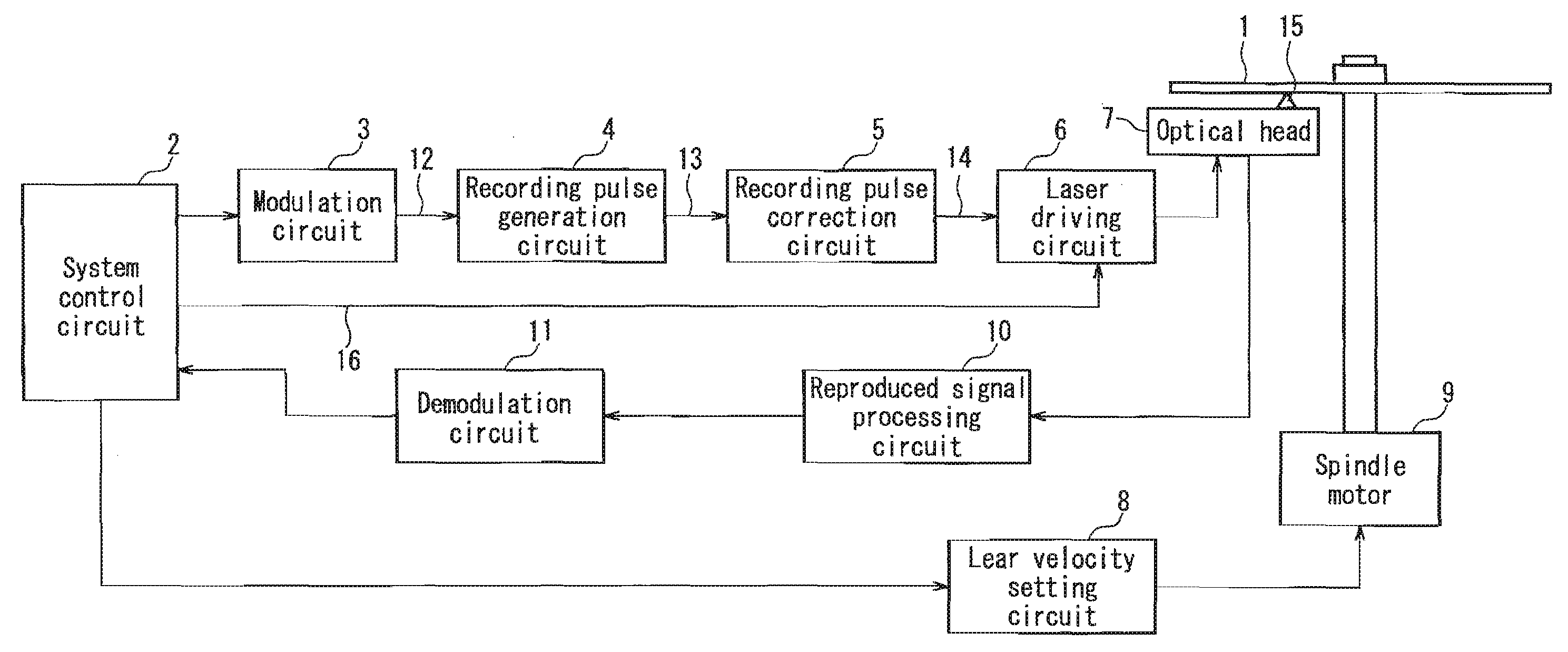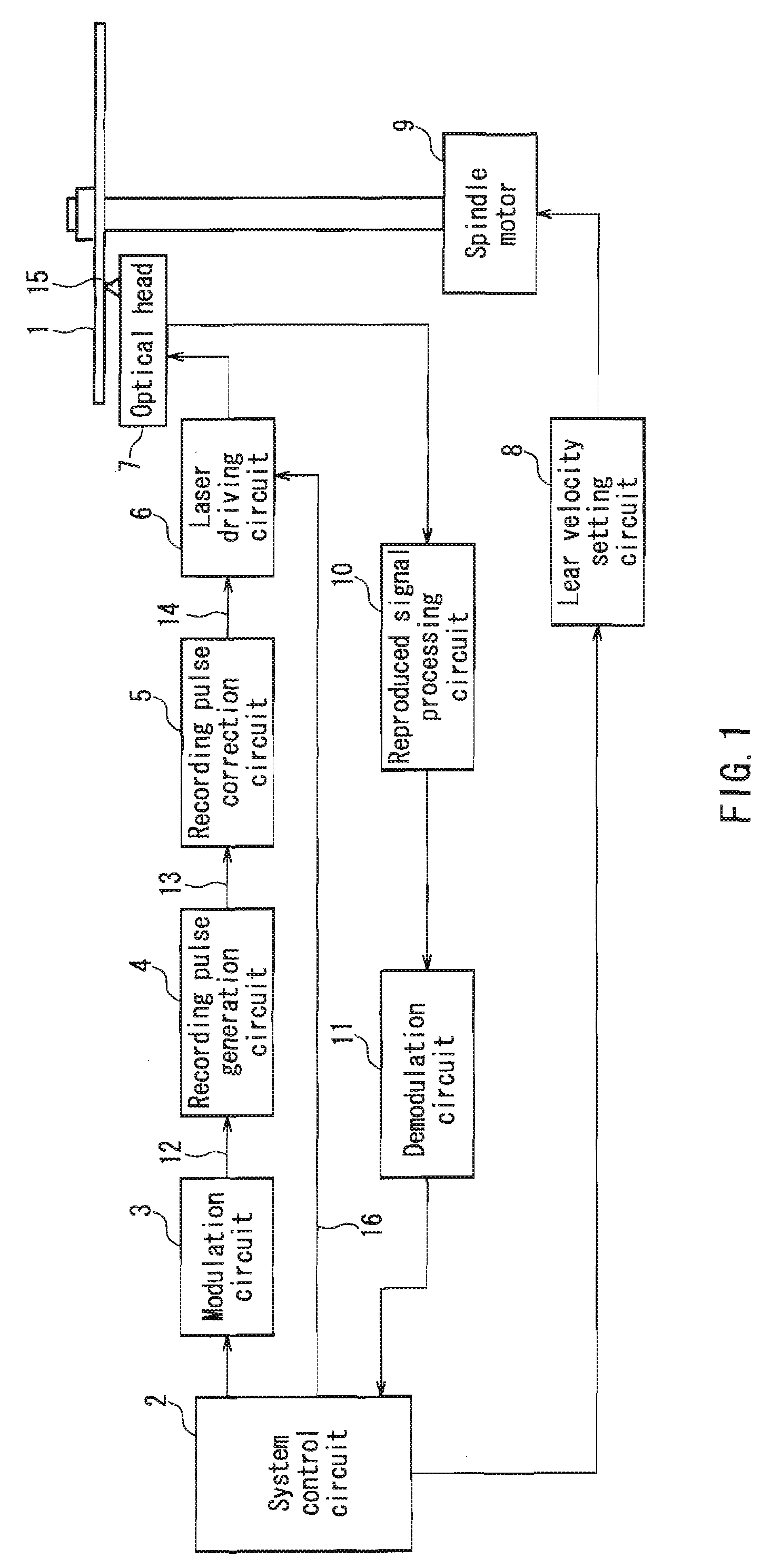Optical information recording method, optical information recording apparatus, and optical information recording medium
a technology of optical information and recording apparatus, applied in the field of optical information recording method and optical information recording apparatus with respect, can solve the problems of excessive cooling speed after melting with laser irradiation in a portion, inability to record data stably with satisfactory signal quality, constant rising and falling time in modulation and light-emission operations of lasers, etc., to achieve satisfactory signal quality, eliminate insufficient overwrite, and simplify the configuration of the apparatus
- Summary
- Abstract
- Description
- Claims
- Application Information
AI Technical Summary
Benefits of technology
Problems solved by technology
Method used
Image
Examples
embodiment 1
[0098]First, the schematic configuration of an optical information recording apparatus in Embodiment 1 will be described with reference to a block diagram of FIG. 1. Although FIG. 1 shows the optical information recording / reproducing apparatus, the embodiment of the present invention is characterized by the configuration of a portion corresponding to a recording apparatus in this optical information recording / reproducing apparatus. Furthermore, the basic configuration of the optical information recording apparatus shown in FIG. 1 is common to the following respective embodiments.
[0099]Reference numeral 1 denotes an optical disk for recording / reproducing data, and reference numeral 2 denotes a system control circuit for controlling the entire recording / reproducing apparatus. Based on a signal supplied from a system control circuit 2, a modulation circuit 3 generates a binarized modulation signal 12 in accordance with data to be recorded. A recording pulse generation circuit 4 generat...
embodiment 2
[0128]Next, an optical information recording method and an optical information recording apparatus in Embodiment 2 will be described with reference to the flow chart of FIG. 7 and the operation diagrams of FIGS. 8 to 11. The basic configuration of the optical information recording apparatus in the present embodiment is the same as that of Embodiment 1 shown in FIG. 1.
[0129]FIG. 7 shows a recording procedure according to the optical information recording method of the present embodiment. FIG. 8 shows a signal waveform and a recorded pattern on a track in the case of recording with a high linear velocity by the optical information recording method of the present embodiment. FIG. 9 shows a signal waveform and a recorded pattern in the case of recording with a low linear velocity. FIGS. 10 and 11 respectively show a signal waveform and a recorded pattern when the width of a leading pulse is varied in the case of recording with a low linear velocity. FIGS. 8 to 11 show an operation exemp...
embodiment 3
[0148]In the above-mentioned two embodiments, the case where data is recorded at two kinds of linear velocities: a low linear velocity v1 and a high linear velocity v2 has been described. In a CAV recording system, the linear velocity and the transfer rate are varied continuously depending upon the recording / reproducing position on a medium. In such a case, it is preferable that, by smoothly connecting the light-emission waveform at the low linear velocity v1 to the light-emission waveform at the high linear velocity v2, the light-emission waveform at an intermediate linear velocity is determined. The present embodiment is an example in which the optical information recording method of Embodiment 1 or 2 is configured in such an embodiment.
[0149]FIG. 12 shows an example of setting a trailing pulse width when data is recorded with a linear velocity varied continuously in a range of v1 to v2 in Embodiment 1. At the linear velocity v1, light is emitted with the light-emission waveform o...
PUM
| Property | Measurement | Unit |
|---|---|---|
| length | aaaaa | aaaaa |
| heights | aaaaa | aaaaa |
| linear velocities | aaaaa | aaaaa |
Abstract
Description
Claims
Application Information
 Login to View More
Login to View More - Generate Ideas
- Intellectual Property
- Life Sciences
- Materials
- Tech Scout
- Unparalleled Data Quality
- Higher Quality Content
- 60% Fewer Hallucinations
Browse by: Latest US Patents, China's latest patents, Technical Efficacy Thesaurus, Application Domain, Technology Topic, Popular Technical Reports.
© 2025 PatSnap. All rights reserved.Legal|Privacy policy|Modern Slavery Act Transparency Statement|Sitemap|About US| Contact US: help@patsnap.com



